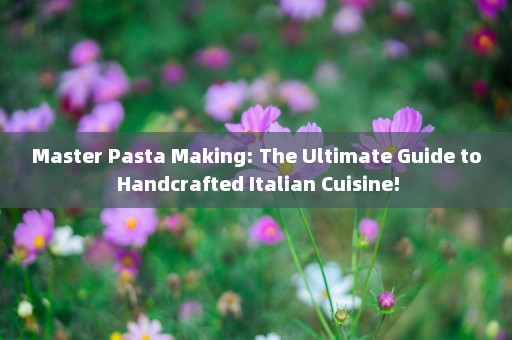Picture this: It's a beautiful Sunday afternoon, and you've just invited your closest friends over for a mouthwatering Italian dinner. As the aroma of freshly baked garlic bread fills the air, you serve up a steaming plate of handcrafted pasta, straight from your very own kitchen. Your friends are in awe, and you can't help but feel a sense of pride. If you've ever dreamt of becoming a pasta-making maestro, then read on, because this ultimate guide will transform you into one!

My Journey to Pasta Mastery
Like many of you, I was once a pasta novice, relying on store-bought versions and takeaway meals to satisfy my Italian cuisine cravings. But one fateful trip to Italy changed everything. I witnessed the art of pasta making firsthand and was immediately captivated. I vowed to master this craft and bring the joy of fresh, homemade pasta to my loved ones.
After years of practice, countless batches, and even a few culinary disasters, I've honed my pasta-making skills. Today, I'm going to share my journey, insights, and practical instructions to help you embark on your own path to pasta mastery.
Ingredients and Tools: The Building Blocks of Pasta Perfection
Before we dive into the process, let's discuss the essential ingredients and tools you'll need.
Ingredients:
- 00 flour (high-quality Italian flour)
- semolina flour (optional, for dusting)
- eggs (room temperature)
- water (room temperature)
Note: While many recipes call for all-purpose flour, using 00 flour will yield a softer, more authentic texture.
Tools:
- pasta machine (manual or electric)
- pasta cutter (optional, for creating different shapes)
- rolling pin (if not using a pasta machine)
- bench scraper or knife
- clean kitchen towels or pasta drying rack
- large mixing bowl
- fork
Step-by-Step Guide: Crafting the Perfect Pasta
Step 1: Mixing the Dough
Start by creating a well in the center of your mixing bowl with 300g of 00 flour. Crack two room temperature eggs into the well, along with a pinch of salt. Using a fork, gently whisk the eggs while gradually incorporating the flour from the walls of the well. Add water, one tablespoon at a time, until the dough starts to come together.
Here's a pro tip: Instead of adding water all at once, sprinkle it over the dough and let it absorb before adding more. This method ensures the dough doesn't become too sticky.
Step 2: Kneading the Dough
Transfer the dough onto a floured surface and start kneading. This process is crucial for developing the gluten structure, which gives pasta its elasticity and bite. Knead for approximately 10 minutes, or until the dough is smooth and elastic.
According to a study published in the Journal of Food Science, proper kneading not only improves the texture but also enhances the cooking quality of pasta.
Step 3: Resting the Dough
Cover your dough with a clean kitchen towel and let it rest for 30 minutes to 1 hour. This resting period allows the gluten to relax, making it easier to roll out and shape.
Step 4: Rolling and Cutting the Dough
Divide the dough into four equal pieces. If you're using a pasta machine, start with the widest setting and gradually work your way down to the desired thickness. Dust the pasta sheets with semolina flour to prevent sticking.
For those without a pasta machine, use a rolling pin to achieve a thin, even sheet of dough. Be patient and consistent with your rolling technique.
Once the pasta sheets are ready, you can either cut them into your desired shapes or pass them through the pasta cutter attachment of your machine. Classic shapes like fettuccine, tagliatelle, and pappardelle are always crowd favorites.
Step 5: Drying and Storing the Pasta
Hang your freshly cut pasta on a pasta drying rack or lay it out on clean kitchen towels to dry for approximately 1-2 hours. This step is essential to prevent the pasta from sticking together during cooking.
If you're not cooking the pasta immediately, you can store it in an airtight container for up to 3 days. Alternatively, you can freeze the pasta for longer storage, ensuring it remains fresh and ready to use.
Key Pointers for Perfect Pasta Every Time
- Always use room temperature eggs and water to maintain the consistency of the dough.
- Avoid over-kneading, as it can make the dough tough and chewy.
- Regularly dust your pasta with semolina flour to prevent sticking.
- Hang your pasta to dry in a well-ventilated area to prevent moisture buildup.
- Boil the pasta in a large pot of salted water to ensure even cooking.
Conclusion
Mastering pasta making is an art form that requires patience, practice, and a deep appreciation for Italian cuisine. By following this ultimate guide, you'll be well on your way to crafting mouthwatering, handcrafted pasta dishes that will impress even the most discerning foodies.
Remember, the key to success lies in the details: quality ingredients, proper technique, and a passion for creating culinary magic. So, roll up your sleeves, dust off your pasta machine, and let's get cooking!
Happy pasta making!
Post a comment

Comment List